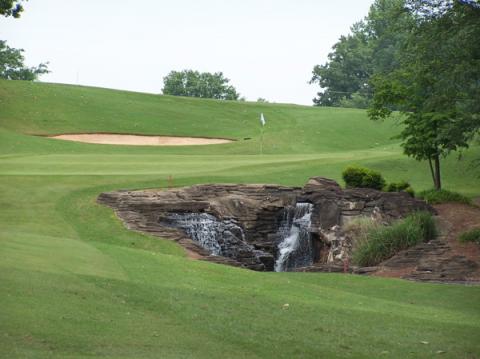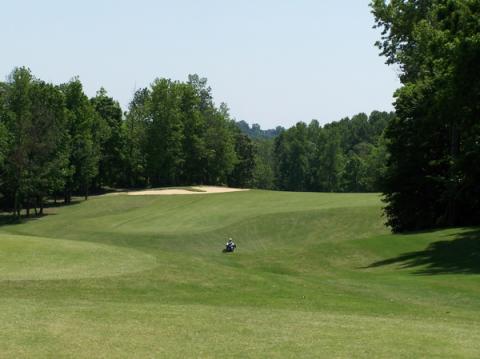
The approach to the 14th green on the Chateau Course is an eye-opener. Given the narrow landing area off the tee, most will be fortunate to have this view for their second shot.
elan
1. Enthusiastic vigor and liveliness.
2. Distinctive style or flair.
You will find more than 18 wonderfully designed and fair holes at the Chateau Elan Resort in Braselton, GA. The problem is you will have to play 36 in order to find them. Golfers with an Outward Bound temperament are going to love the two resort courses at Chateau Elan. The rest of us might consider bringing a compass and pith helmet, as some holes are quite an adventure, totally at odds with the relaxing nature of the resort and its beautifully landscaped surrounding community.
Memorable golf it is; relaxing it is not.
Chateau Elan, both a resort and an upscale golf community, emerged first as a winery when Don Panoz, a pharmaceutical company founder, and his wife Nancy first planted grapes on the surrounding land in
Chateau Elan's two daily-fee golf courses, the Woodlands and Chateau, have plenty of scenery that includes the lovely hills northeast of Atlanta and many huge homes, wonderfully landscaped and never too close to the fairways and greens. We always prefer no homes to any on a golf course, but a lot of thought went into the yin and yang of these courses and the adjacent real estate, and Chateau Elan scores high in that regard. All homes are set well back and above the sloping fairways. For those inclined to live near a big, thriving city - Atlanta is about 45 minutes away - and in a community of folks with the means to afford big, sprawling homes on beautifully landscaped lots, Elan fills the bill and more. (I will discuss Chateau Elan's real estate and amenities in tomorrow's article.)
The centerpieces of Chateau Elan, though, are the golf courses, the two that are available to the public and The Legends, which is for members only. Denis Griffiths, who has done most of his work in the state of Georgia, designed all three courses. The resort also features a walkers' par 3 course by Griffiths. I didn't get to see The Legends during my short visit to Elan, but one online reviewer described it as "manicured in every way," with "greens like glass." I believe it, based on the greens on the Woodlands course and the slightly slower but still fast greens on the Chateau Course.
After two days of walking the Woodlands and Chateau courses, I do have to wonder to what type of member or resort guest they will appeal. At times brutal, at times bizarre, and sometimes both, the courses are testing the endurance this week of a bunch of collegiate golfers competing in the NCAA Division III Championships. Consider that the best player on one college team shot a 71 the first day on the slightly easier Chateau Course and then a 96 the second day on the relentless Woodlands, and you have some idea of the ups and downs the layouts present (literally and figuratively). Only one player in the field of 180 golfers, Scott Harris Jr., of St. John Fisher College, was under par after the first three days, an astounding performance on these two courses.
The idiosyncratic par 4 17th hole on the easier Chateau Course might be the oddest of all. At just 372 yards from the back tees, you have two choices of landing areas, neither of them easily reached. A mown area the shape of a button and the size of a modestly sized green sits in a hollow on the lower left side of
 the fairway, the 150-yard post plunked down in its middle. Well above and to the right is a long narrow strip of fairway that begins about 190 yards from the back tees. These two slices of fairway are separated by an eight-foot-high slope of hairy rough in what appears to be from the tee the center of the fairway. Heavily wooded areas frame both sides of the fairway, and a creek gobbles up any shots that are played too cautiously short of the fairway. From the 150-yard stake, you cannot see the left two-thirds of the wide, elevated green because trees block out any shots but those placed perfectly in the center of the upper fairway. Sand bunkers in front and behind the green complicate matters and make the hole's rating as the 14th most difficult on the course hard to understand. In reality, the 17th was the hardest hole on the Chateau Course on day two of the NCAA tournament, playing ¾ of a stroke over par...for some of the best collegiate golfers in the land.
the fairway, the 150-yard post plunked down in its middle. Well above and to the right is a long narrow strip of fairway that begins about 190 yards from the back tees. These two slices of fairway are separated by an eight-foot-high slope of hairy rough in what appears to be from the tee the center of the fairway. Heavily wooded areas frame both sides of the fairway, and a creek gobbles up any shots that are played too cautiously short of the fairway. From the 150-yard stake, you cannot see the left two-thirds of the wide, elevated green because trees block out any shots but those placed perfectly in the center of the upper fairway. Sand bunkers in front and behind the green complicate matters and make the hole's rating as the 14th most difficult on the course hard to understand. In reality, the 17th was the hardest hole on the Chateau Course on day two of the NCAA tournament, playing ¾ of a stroke over par...for some of the best collegiate golfers in the land.But the 17th on the Chateau Course had nothing on the 14th on the Woodlands. The 412-yard par 4 played one full stroke above par the first two days of the tournament. The hole claimed 39 double bogies and 17 "others" (i.e. more than double bogey) during the first two days (the Chateau Course is being used for the final two rounds). The drive on the 14th (see photos at bottom) is blind over a hill to a fairway that snakes around a bunker at left and slopes severely down to the forest on the right before making a hard left around the bunker and sloping down to the woods on the left. The landing area is narrow and cannot be seen from the tee. The long-iron, uphill approach to the green must negotiate a large, baseball-glove-shaped trap that protects the entire left side, with a creek in front of it. The two-tiered green is mostly bottom tier, and when the pin is on top, any aggressive play could yield a delicate downhill chip with potential to wind up on the bottom tier anyway. A false front will penalize any false notions of birdie when the pin is close to that front edge.
On a course this demanding of well-placed drives, I thought the out of bounds stakes were too tight to the
You need to be a 20 year old to have the stamina to walk either of the two courses at Chateau Elan. To begin with, the distance to the first tees is hundreds of yards (a good ½ mile or so to the Woodlands tee). And the up and down nature of the courses, especially the Woodlands, would have left me gasping for air at some points even if I were in decent shape. I would not be interested in playing either course on days when carts were restricted to paths only.
Chateau Elan's strongest suit is grooming and landscaping. On a lovely spring day, everything seemed beautifully in order both on and off the course, and under the stress of hosting a tournament that attracted hundreds of participants, parents and other spectators in need of guidance, the people in the pro shop could not have been friendlier and more accommodating. Chateau Elan is a high-end resort with great service and an assured air. But if you visit for a vacation or to look at property, make sure you sign up to play each course more than once. You will need at least one practice round to eventually find your way.
Tomorrow I will discuss the housing options and amenities in the surrounding community at Chateau Elan.
Chateau Elan Winery & Resort, 6060 Golf Club Drive, Braselton, GA. 678.425.6051. The Chateau Course tees: Gold 7,030 yards, Green 6484, White 5,900, Burgundy 5,092. Rating/slope: Gold 73.9/137, Green 71.0/131, White 69.1/122, Burgundy 70.1/120. The Woodlands tees: Gold 6,735 yards, Green 6,355, White 5,927, Burgundy 4,850. Rating/slope: Gold 73.1/135, Green 71.1/132, White 68.4/126, Burgundy 69.2/129. The Woodlands and Chateau Courses are both open to the public; the community's Legends course is strictly private. Green fees on the two public courses are $70 weekdays, $50 between noon and 3 p.m. www.chateauelan.com

Collegians who played the 412 yard par 4 14th on the Woodlands Course averaged 4.99 strokes. The tee shot (above) is blind to a narrow fairway below that first sweeps right toward the woods and then left as it approaches the green. When the pin is back on the two tiered green (below), prudent players will leave their approach in the middle of the green and take their chances with a 35-foot uphill putt.
























